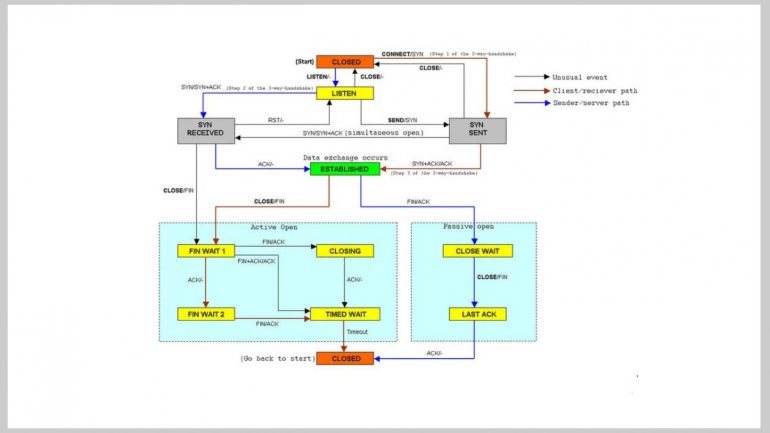Since the 1980s, the Transmission Control Protocol (TCP) has controlled most Internet traffic. TCP remains one of the cornerstones of Internet communication to this day. 9293 with a request for comment (RFC 9293), small changes introduced over the years are now being summarized for the first time and adding a minimum requirement to deal with surcharges.
Adopted by the Internet Engineering Task Force (IETF) in 1981 RFC Specification 793 So was valid for about forty years. The basic transport protocol for the Internet governs communication between a server and a client who wish to exchange IP packets as quickly as possible by using error correction, but there is no concrete information about which way they can be used. They are communicating on the way and how fast is that.
Overall, the TCP specification is about opening and closing a connection and ensuring the complete transmission of data packets, or the method by which the sender and receiver detect and correct transmission errors. Unlike the underlying IP layer and its counterpart UDP (User Datagram Protocol), TCP is a “stateful” protocol, meaning that the two servers involved are aware of the state of the connection.
Consolidation and the New Language
Basically, little has changed from the good old TCP, as described by John Postel, the Internet father in the 1980s. Essentially, the new version is a “merging of various documents accumulated since RFC 793”, explains Professor Michael Scharf from the University of Esslingen. Scharf served as co-chair of the IETF’s TCP Maintenance and Minor Extension Working Group (TCPM) from 2011 to March 2022.
Documents that have now been unified include, for example, a 1989 definition of an algorithm for calculating the period after which the sender must resend a packet that has not been accepted by the recipient (RFC 1122). The most recent unified RFC is from 2012 and eventually has an explanation of the maximum size of a TCP segment. RFC 9293 brings all of these things together, Scharf explained. “Anyone who wants to develop a new TCP implementation will find everything they need here.” Therefore many unified RFCs are obsolete and have become “historical texts”.
Reconstructors probably also classified Postel’s description of the “vision of the TCP” and the reference to the original customer, the US Department of Defense, as historical. On the other hand, the new “Security Considerations” section, which had not yet been considered in Postel’s days, deals with potential attacks and vulnerabilities as well as security mechanisms sometimes offered for them, such as TCPCrypt, which are not very common. is related to.
innovation crowd control
However, the editorial team around Wesley Eddy, CTO of software-defined networking company MTI Systems, made an exception. For the first time, the TCP standard specifies minimum requirements for TCP congestion control.
However, the choice of crowd control algorithms is still left to the implementers and thus remains flexible, as Scharf emphasizes. This is necessary because in the area of congestion control, in addition to the currently frequently used Reno and Cubic, new ones such as Google’s BBR are available. The next generation is already in the works.
However, the new TCP Standards document specifies the minimum requirements that congestion control must comply with in order to avoid overload.
tcp vs quick
Not only is there a stir in the standardization process in congestion control. As with Quicken, TCP has long been a competitor, which some observers believe has a good chance of overtaking the older transport protocol. Quik basically brought Google into standardization; It is based on UDP and brings encryption with it.
Despite the initial boom in Quicken traffic, Sharp sees several areas where TCP will continue to play its role as a base protocol. Server software suitable for small Internet providers is still unavailable. As of now, neither Apache nor NGINX are designed for Quicken, so many websites are accessed without the new protocol. Furthermore, TCP remains the protocol of choice for exchanging routing information, i.e. for BGP traffic.
And while part of Quicken’s speed advantage is due to the fact that engineers have intertwined multiple protocol layers, TCP still draws from its traditional concept and with more easily understandable functionality because it uses only one communication layer. maps to. Faced with a choice for some developers, it may be the deciding factor in favor of TCP as it promises faster implementation and easier error analysis.
heterogeneous infrastructure
However, Scharf anticipates that some of the innovations brought by Quicken will also be considered for TCP. “For RFC 9293, it was decided to stay as close as possible to the text of RFC 793 in terms of protocol functionality.” This is also due to the sheer number of implementations. The closer RFC 9293 stays to the original wording, the less likely it is that future implementations will have errors due to different interpretations. For the future, though, he certainly sees an opportunity to teach good old TCP to Quick Try and Test Functions.

,

Reader. Organizer. General creator. Zombie fanatic. Alcohol advocate. Food junkie. Bacon ninja.






